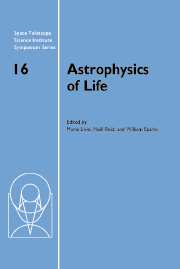 Astrophysics of Life
Astrophysics of Life Book contents
- Frontmatter
- Contents
- Participants
- Preface
- A voyage from dark clouds to the early Earth
- Galactic environment of the Sun and stars: Interstellar and interplanetary material
- Transits
- Planet migration
- Organic synthesis in space
- The vegetation red edge spectroscopic feature as a surface biomarker
- Search for extra-solar planets through gravitational lensing
- The Galactic Habitable Zone
- Cosmology and life
Search for extra-solar planets through gravitational lensing
Published online by Cambridge University Press: 29 August 2009
- Frontmatter
- Contents
- Participants
- Preface
- A voyage from dark clouds to the early Earth
- Galactic environment of the Sun and stars: Interstellar and interplanetary material
- Transits
- Planet migration
- Organic synthesis in space
- The vegetation red edge spectroscopic feature as a surface biomarker
- Search for extra-solar planets through gravitational lensing
- The Galactic Habitable Zone
- Cosmology and life
Summary
Gravitational microlensing offers a powerful technique to search for extra-solar planets around lensing stars via short-timescale amplifications produced by the planet on the microlensing lightcurve. This method is technologically simple, can be carried out with a network of relatively small ground-based telescopes, and is sensitive down to earth-mass planets.
More than 100 microlensing events towards the Galactic bulge have been monitored by the PLANET collaboration to look for such planetary signals. No clear planetary signal has been detected, which implies that less than 33% of the lensing stars have Jupiter-mass planets with orbital radii of 1.5–4 AU. Since other techniques are currently not sensitive to the outer portion of these orbital radii, these are the best current limits on extra-solar planets at these orbital separations.
Isolated planetary-mass objects can also reveal themselves as short timescale microlensing events in a monitoring program. Lack of such short-timescale events in the MACHO and EROS database towards the LMC suggests that the contribution of planetary-mass objects is less than 10% of the halo dark matter.
Gravitational microlensing as a tool
Uranus is roughly a 6th magnitude object, and is almost a naked-eye object. Yet it was discovered only in 1791, long after the telescope was invented, and it took a great astronomer like Sir William Herschel to do so (at least by some accounts). Uranus was the last planet to be discovered by its direct light.
- Type
- Chapter
- Information
- Astrophysics of LifeProceedings of the Space Telescope Science Institute Symposium, held in Baltimore, Maryland May 6–9, 2002, pp. 76 - 88Publisher: Cambridge University PressPrint publication year: 2005
